Crypto Macro Monthly Report: Tariff War Accelerates Global Asset Difference, Crypto Rises Becomes a New Balance Pivot

Reprinted from panewslab
05/09/2025·15DIn early April, Trump's reciprocal tariff policy triggered a plunge in global assets, and Trump then relaxed and admitted that tariffs would be "significantly lowered" and confirmed that Fed Chairman Powell would remain in office, eased concerns about the turmoil of the Federal Reserve's leadership. After investors were appeased, it triggered a new wave of risk appetite, and Bitcoin took the lead in rising strongly.

Judging from the data, although the hard macroeconomic indicators such as consumption and employment in the United States have not yet been affected by substantial impact in April, the risks have increased significantly: 151,000 new non-farm employment in the United States (expected 170,000), and the unemployment rate rose to 4.1%, which is better than expected; but on the other hand, the "reciprocal tariff" policy implemented by the Trump administration in April soared from 2.4% to 21.4%, causing the import commodity price index to rise by 18.6% year-on-year. Among them, the pre-tariff purchase wave of automobile tariffs drove retail sales to surge by 1.4% month-on-month in March, but the actual consumption momentum after excluding automobiles only increased by 0.5%, down 0.15 percentage points from February.
This policy-driven short-term consumption overdraft is in sharp contrast to the largest decline in April's consumer confidence index since 1978: the initial value of the University of Michigan's consumer confidence index in April is 50.8, which is significantly lower than the expected 53.5, with a value of 57 in March, and is the fourth consecutive month of decline. In April, the University of Michigan 's first-year inflation expectation surged to 6.7%, a record high since November 1981, with an expected 5.2% and a previous value of 5%. The initial value of the five-year inflation expectation was 4.4%, the highest level since June 1991, with an expected 4.3% and a previous value of 4.1%. Soft indicators such as expectations have weakened significantly, revealing various unsustainability.
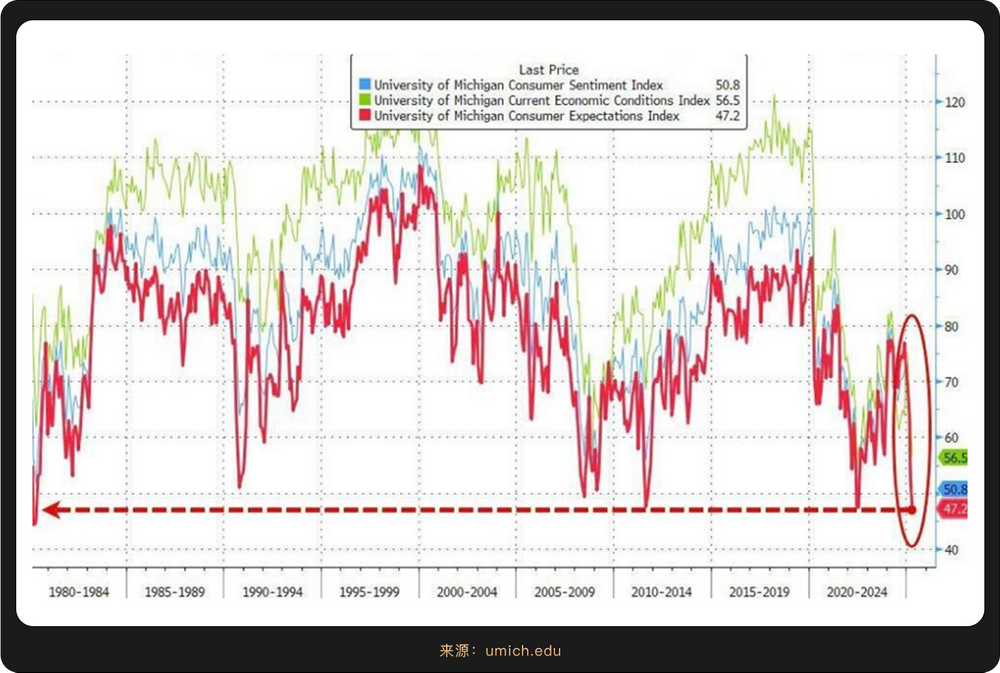
The US economy is facing the dilemma of stagflation of "high inflation-low growth-policy conflict". The backlash effect of tariff policies will accelerate through the triple channels of supply chain, employment market and consumer confidence. The International Monetary Fund (IMF) released the latest issue of the World Economic Outlook Report, reducing global economic growth expectations in 2025 from 3.3% to 2.8%, of which the U.S. growth rate expected to be halved to 1.8%, and the euro zone dropped to 0.7%.
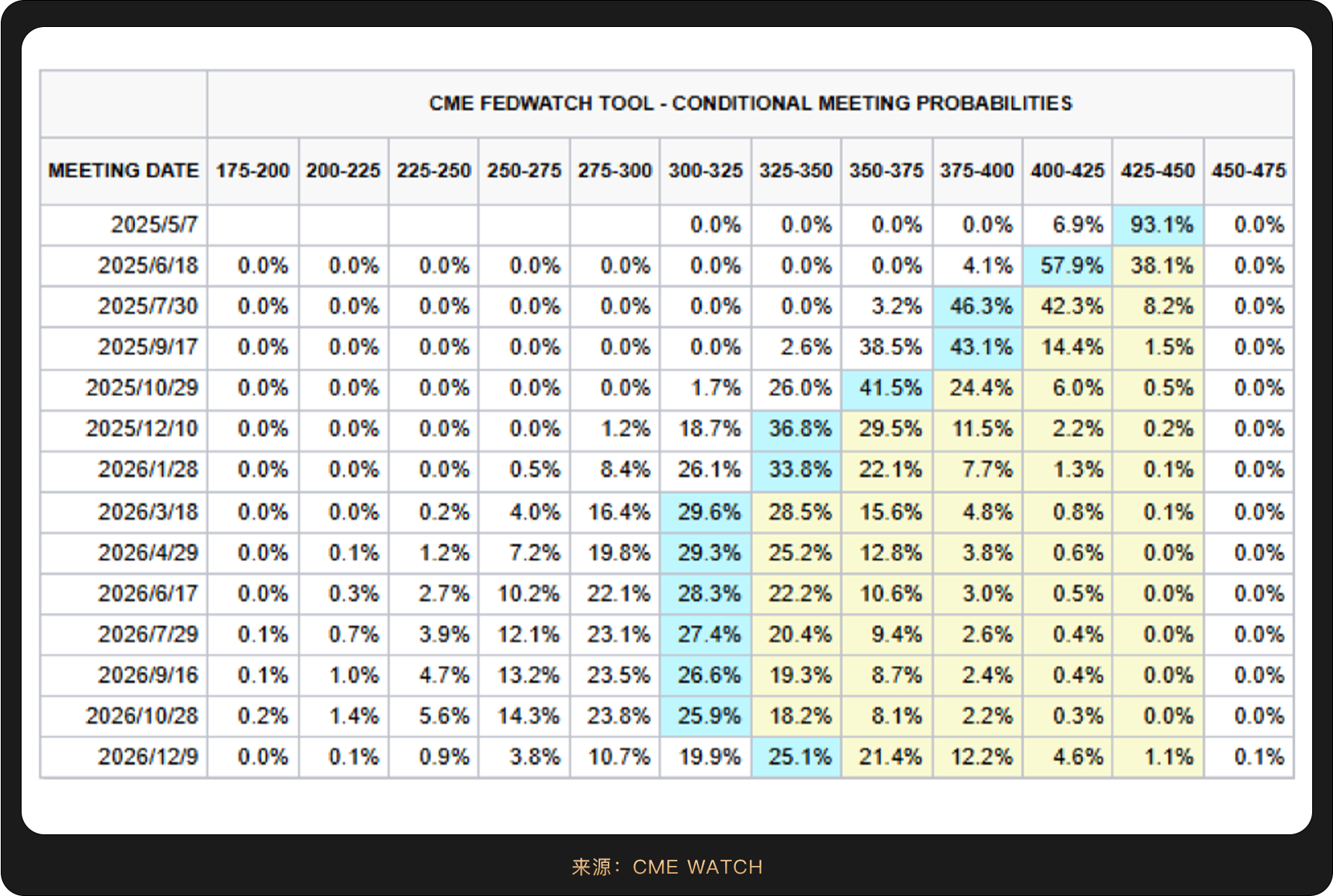
Looking at the Fed, the Fed's PCE inflation rate has been above the 2% target for 14 consecutive months. Short-term inflation expectations in April jumped to 3.8%, a new high since 1982. Under this circumstance, the Federal Reserve decided to keep the federal funds rate unchanged in the range of 4.25%-4.50%, which is obviously a triple dilemma. It is impossible to move: interest rate cuts may aggravate inflation expectations from deanning, interest rate hikes will accelerate the economic recession, and maintaining the status quo will face presidential pressure. Federal Reserve Chairman Powell said policymakers will continue to observe the economic situation, especially inflation and growth data, and wait for more clear signals before considering adjusting interest rates.
As the "anchor" of global monetary policy, the Federal Reserve is experiencing the most severe test of policy imbalance in nearly 40 years. According to general forecasts from the outside world, in the most optimistic case, if inflation drops faster than expected, the Fed may turn to neutral interest rates faster and even begin cutting interest rates in the first half of 2025 (May or June).

Throughout April, US dollar assets were hit by the double attacks of policy uncertainty and economic downturn, especially in the first half of the month, the market sentiment was extremely pessimistic; first of all, on April 3, the three major U.S. stock indexes suffered a historic drop, the Dow Jones Industrial Average fell 5.50% in a single day, the Nasdaq fell 5.82%, and the S&P 500 fell 5.98%, setting the largest single-day drop since March 2020 by 1. Technology stocks have become the hardest hit area, with companies such as Apple, Tesla, and Nvidia falling sharply due to rising supply chain costs and restrictions on exports. Among them, Nike plummeted by 14.44% in a single day due to the impact of high tariffs from Vietnam and Indonesia. Bruce Casman, head of economic research at JPMorgan Chase, even raised the probability of a U.S. recession to 79%, reflecting the market's deep concerns about the long-term negative impact of tariff policies.
US stocks rebounded significantly at the end of the month. On April 23, the S&P 500 rose 9.52% in a single day, and the Nasdaq rose 12.16%, setting the second largest single-day increase in history. The rebound is partly due to market expectations that tariff policy may be adjusted, such as the U.S. Customs and Border Protection's announcement of exemption from tariffs on some electronic products. In addition, the financial reports of some tech giants exceeded expectations have also boosted market confidence, such as Google's AI business growth and a $70 billion stock buyback plan.
Although US stocks recovered most of the tariff declines at the end of the month, Trump's policy uncertainty in the future has formed a stronger resonance with the downward trend of the US economy, and US stocks may still bear the brunt of the first. Wall Street generally believes that this rebound may only be a "technical repair in a bear market." Bank of America strategist Michael Hartnett warned that investors should “sell at highs” as the market still faces policy uncertainty and risk of recession. Goldman Sachs also pointed out that if the tariff policy is not substantially relaxed, US stocks may be under pressure again.
Before the Fed restarted interest rate cuts to save the market and made progress in tariff negotiations, the short-term rebound of U.S. stocks was still shrouded in shadows.

Although also hit hard by the tariff stick in April, Bitcoin redefined its position in global assets by exceeding market expectations:
First of all, in mid-to-late April, the price of Bitcoin strongly broke through the $94,000 mark, with a single-day increase of more than 3%, setting a new high this year. This rise echoes the trend of gold hitting a new high, highlighting its attributes as "digital gold". In sharp contrast to the US stock market that was hit by tariff policies during the same period, Bitcoin's volatility in April dropped significantly. This stability has attracted accelerated entry of medium and long-term funds - from April 21 to 23, the net inflow of US Bitcoin spot ETF exceeded US$900 million for three consecutive days, pushing the global total market value of cryptocurrencies exceeding US$3 trillion, rekindling the bullish sentiment of the entire cryptocurrency market. Investor confidence once rose to the highest level in more than two months, and the US media called it an alternative option to seek safe havens. In this wave of increase, long-term holders (LTHs) collective wealth has increased significantly. According to CryptoQuant data, from April 1 to 23, long-term holders achieved a market value of $345 billion to $371 billion, an increase of $26 billion, indicating that long-term holders are rewarded for their persistence.
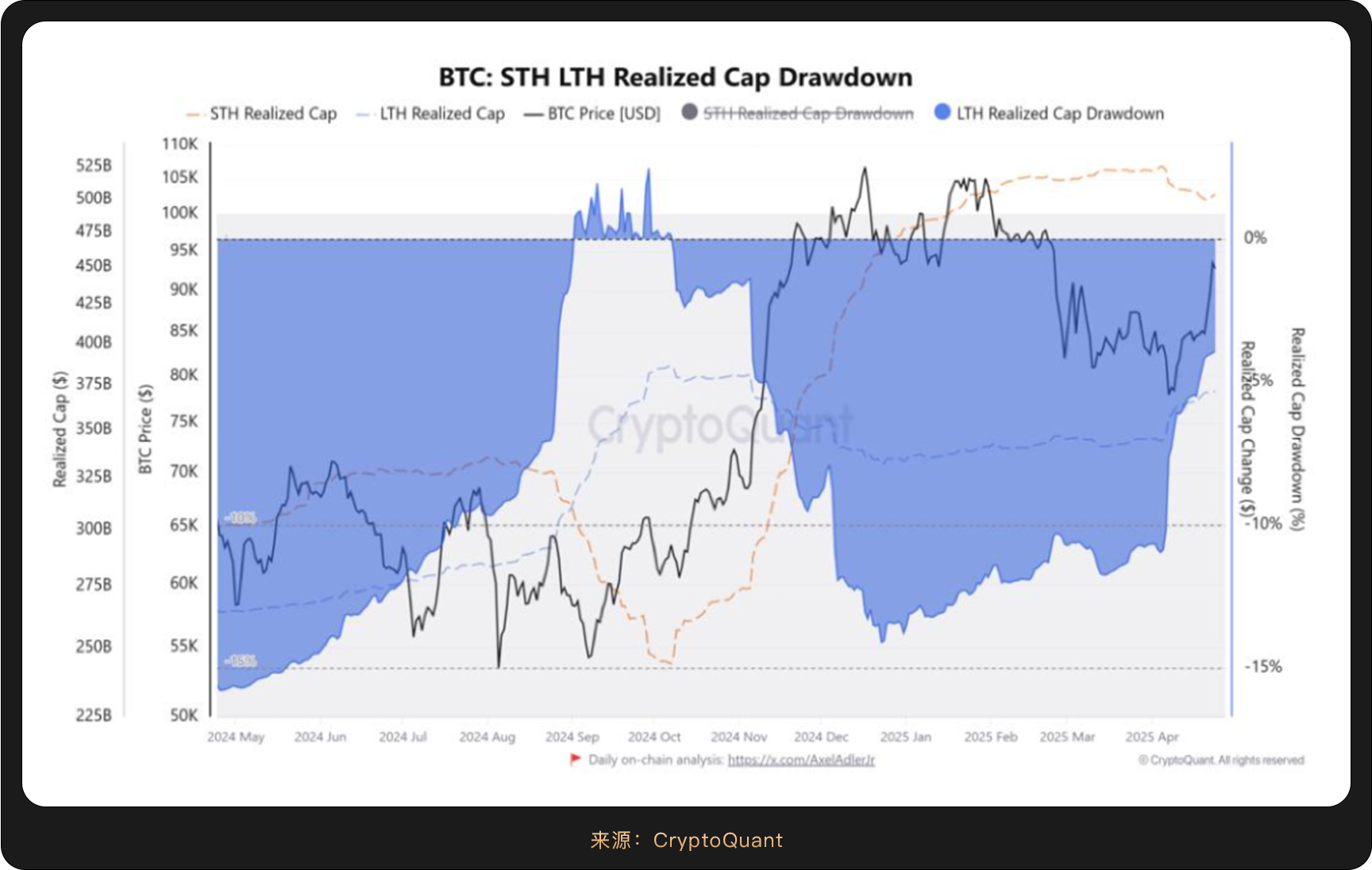
According to CryptoQuant statistics, Bitcoin experienced a pullback of more than 30% from January to early April, which is consistent with the historical market cycle rules of 2013, 2017 and 2021. It usually occurs after hitting a new high, and then resumes the upward trend after washing out weaker investors. In addition, the decoupling of Bitcoin from traditional markets and investors' demand for non-related assets (such as gold prices rising to a new high of $3,500) has strengthened long-term holders' confidence in Bitcoin's store of value.
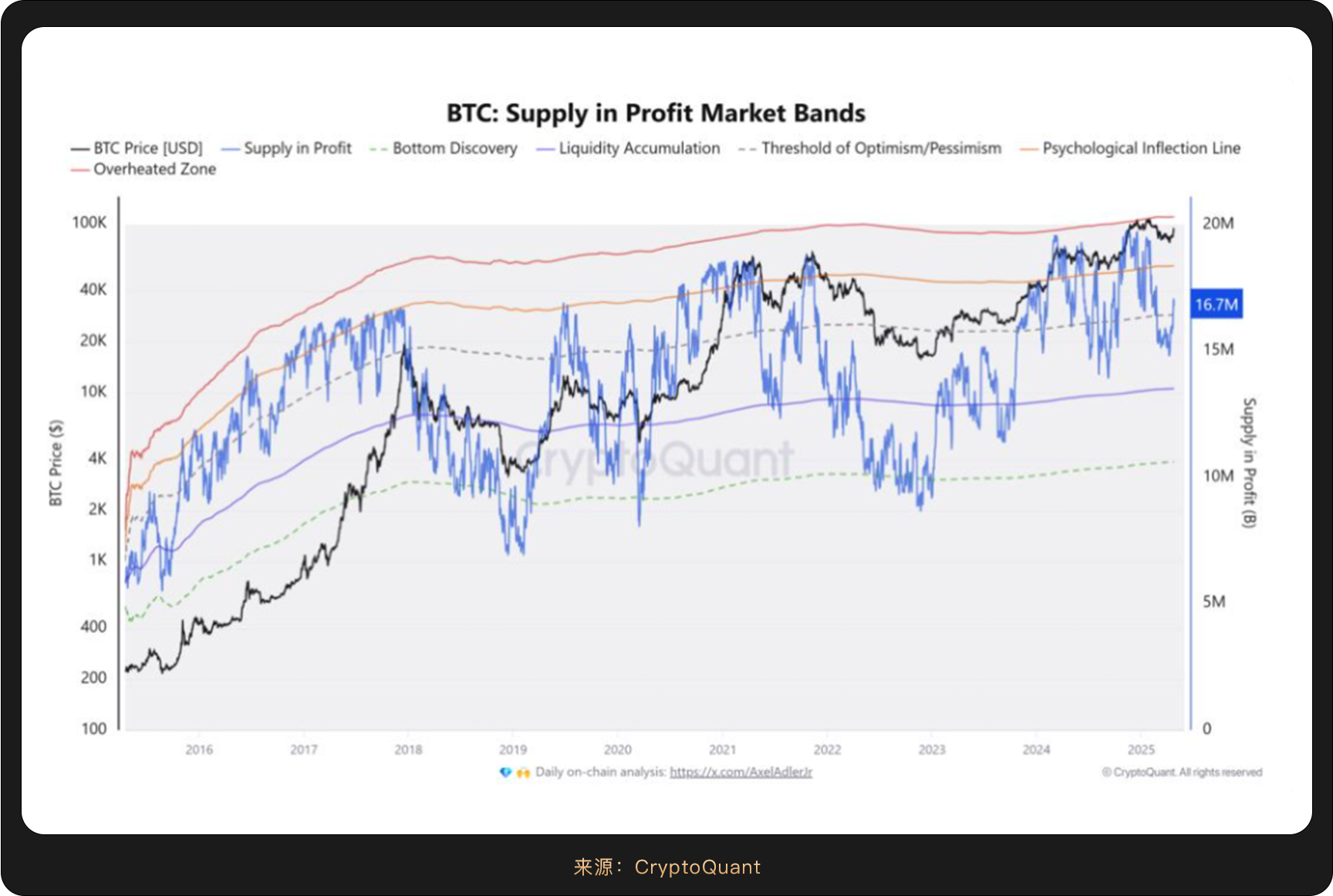
According to Cointelegraph, there are currently 16.7 million BTCs in various wallets that are profitable - a level commonly known as the "threshold of optimism". Historically, similar models in 2016, 2020 and early 2024 have led the bull market. When profitable supply continues to stay above this area, it often boosts investor confidence and triggers sustained price momentum, which usually drives Bitcoin to record all-time highs in a few months. After Bitcoin exceeded $90,000, the number of active addresses on-chain surged by 15%, and the number of Giant Whale Wallet (holding more than 1,000 BTC) hit a four-month high, further verifying the bullish consensus of funds.
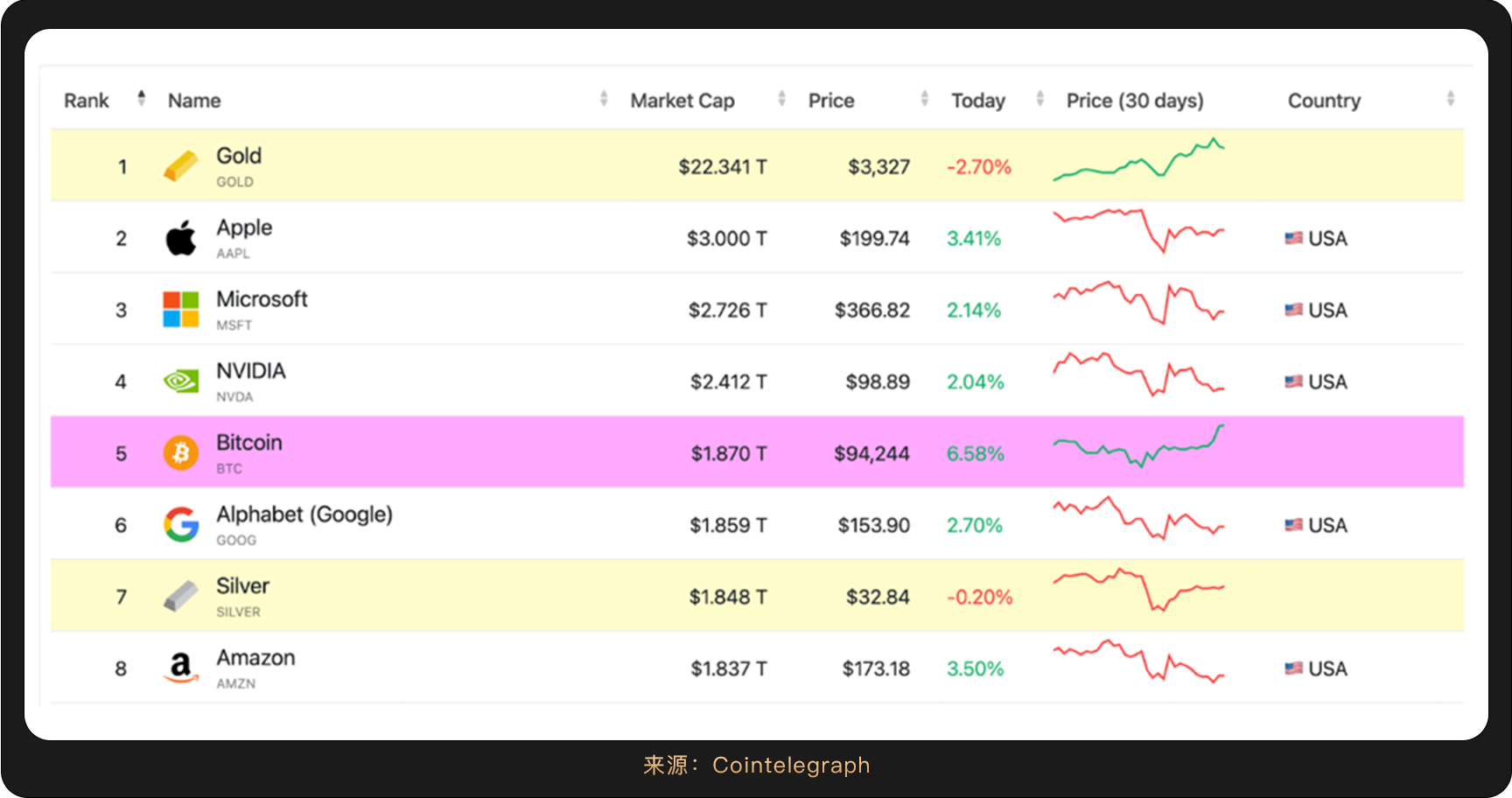
Driven by the surge in Bitcoin prices, the total market value of global cryptocurrencies exceeded US$3 trillion on April 23, and the market value of Bitcoin reached US$1.847 trillion, surpassing Alphabet (Google) and Amazon, as well as precious metal silver, and becoming the fifth largest asset behind gold (22.344 trillion US dollars), Apple (3.000 trillion US dollars), Microsoft (2.726 trillion US dollars), and Nvidia (2.412 trillion US dollars).
The increase in rankings makes Bitcoin the only digital asset in the world's top ten asset list. What is more noteworthy is that the long-term correlation between Bitcoin and US technology stocks (especially the Nasdaq 100 index) has been "decoupled". During April, the price of Bitcoin soared 15%, while the Nasdaq 100 index rose only 4.5% during the same period, highlighting its independent market performance and changes in asset attributes. Compared with the stock market volatility caused by April's tariff policies, Bitcoin has recently shown stronger price stability and lower volatility, which may drive more listed companies to consider allocating crypto assets in their financial strategies.
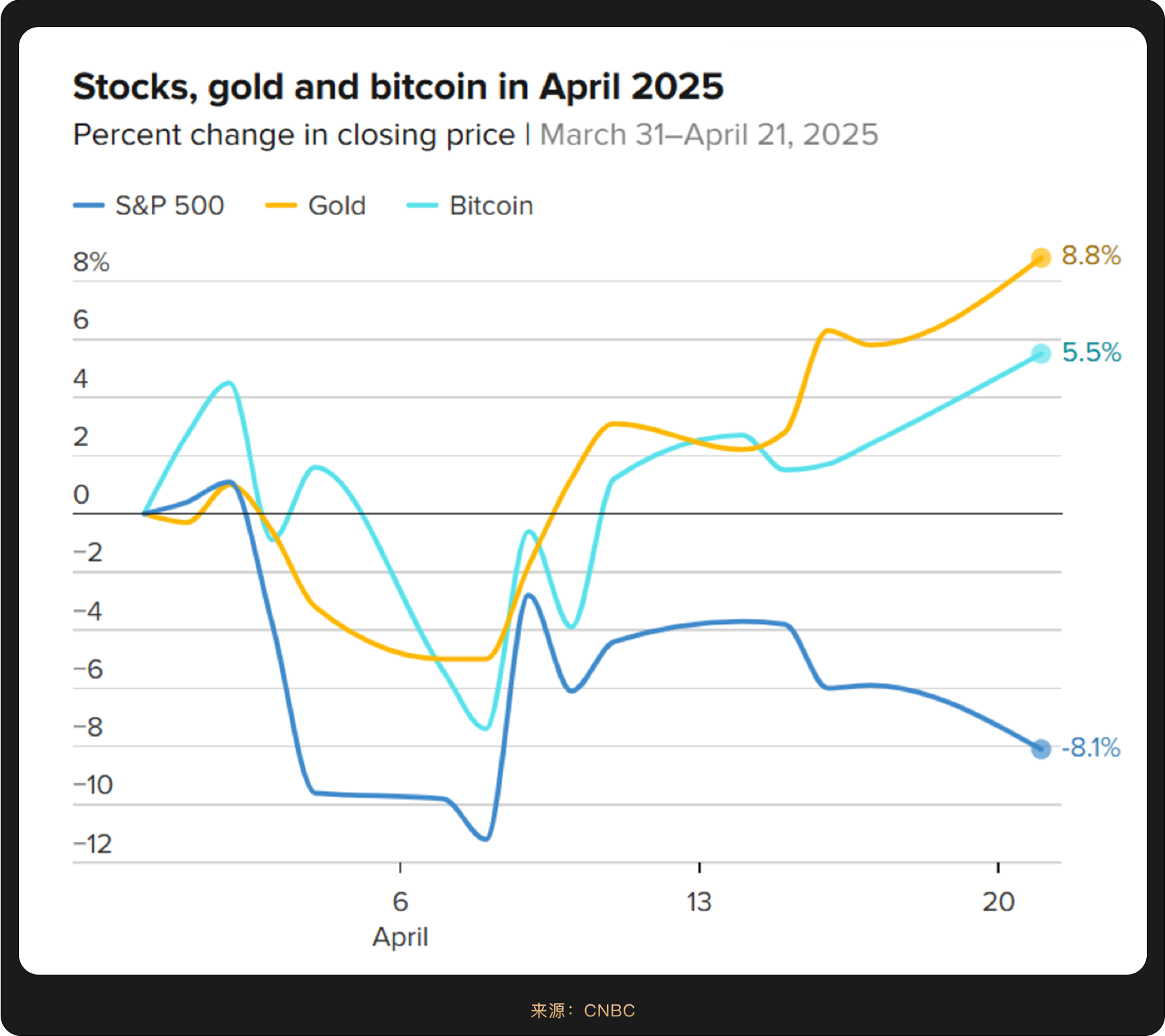
There is no doubt that crypto assets are rewriting the underlying logic of global asset pricing. In April, ARK Invest founder Cathie Wood, based on the increasing institutional interest and the increasing acceptance of Bitcoin as a "digital gold", has significantly raised its target price for Bitcoin in 2030 from $1.5 million to $2.4 million.

At present, the market rebound in April is a temporary elimination of doubts about market collapse and economic recession caused by tariffs. Further trends will depend on whether the tariff war can end in time and the trend of the US economy. Given that the most optimistic interest rate cuts are also after January, market differences are still there, and short-term fluctuations are inevitable. When traditional financial markets fall into volatile due to tariff wars and economic cycles, the independence and anti-cyclical attributes of crypto assets may attract more funds seeking diversified asset allocation.

